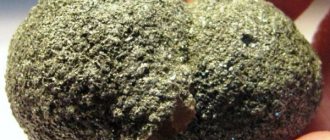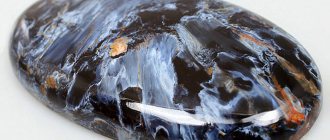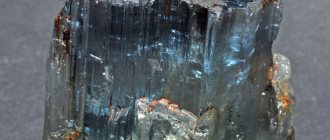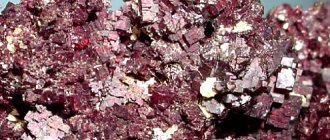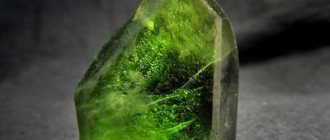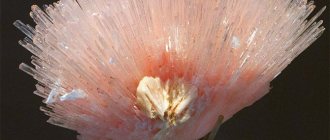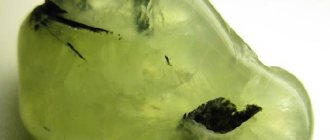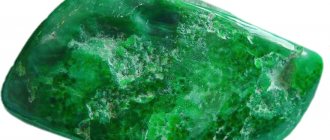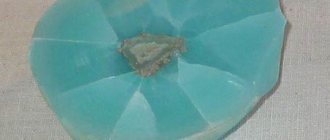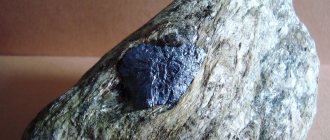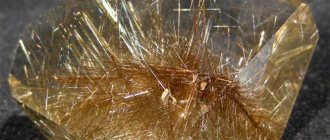| Category | Hydroxyls (minerals) |
| Title in English | Goethite |
| Formula | α-Fe3+O(OH) |
| Group | Group of hydrous oxides |
| Color | Black Brown |
| Stroke color | Brown |
| Shine | Diamond, Matte, Silky |
| Transparency | Opaque |
| singonia | Rhombic |
| Hardness | 5 — 5,5 |
| Cleavage | Perfect |
| Density, g/cm³ | 3,3 — 4,3 |
| Kink | Uneven, Splintered |
| origin of name | The mineral received the official name goethite in honor of the famous poet Johann Wolfgang Goethe. In addition, goethite has synonymous names. In the Czech Republic, the mineral was named pshibramite. It was formed from the name of the place where the mineral was found. It was a town in the Central Bohemian region of Przybramit. The history of the name fullonite comes from one incident on Wolf Island, located in the White Sea. One day, needle-shaped goethite crystals were discovered here and named Fullon in honor of the head of the Olonets district. The boss received this favor for sending images of the discovered mineral to France. Fullonite has another name, which it received much later - ogenite. Derived from the place of discovery: Onega Bay of the White Sea. |
| Morphology | Goethite crystals come in needle-shaped and prismatic forms. Also, the mineral has geodes, kidney-shaped, grape-shaped and stalactite discharges. The gothite also contains continuous masses, oolites, and also concretions. |
The mineral goethite is formed in iron ore ores later than other rocks, and has become widely known relatively recently. The stone was named in honor of Johann Wolfgang Goethe, the greatest German poet and thinker. This is due to the fact that Goethe, among his other interests, was fond of studying geology and also collecting minerals. In addition, goethite also occurs under other names; its specimens are often called chilenites, alumogethites and mesabites. The color palette of the mineral starts from dark brown and continues all the way to rich black. The gem is characterized by a beautiful silky, diamond-like shine.
Physicochemical characteristics
| Property | Description |
| Formula | FeO(OH) |
| Hardness | 5 — 5,5 |
| Density | 3.3 - 4.3 g/cm³ |
| singonia | Rhombic (planaxial) |
| Kink | Uneven, fragile |
| Cleavage | Perfect by {010} |
| Transparency | Translucent or opaque |
| Shine | Diamond |
| Color | Shades of brown and yellow |
Varieties and colors
Now there are five varieties of the mineral:
- has the appearance of needle-shaped iron ore. Needle-shaped crystals formed on brown iron ore. Or they are transparent amethyst boulders. These minerals are ground and made into jewelry in the form of beads,
- table-shaped crystals formed on ore-bearing veins. They are called Ruby mica. In the USA and England they are most often found,
- radio-radiated nuggets-aggregates of incredible beauty, having a brownish-brown tint, on veins of the iron ore Lepidocrocite,
- a very rare and unique species often found in India. It is located on veins of lead ore Przybrabit (velvet blende).
The stone is black in color and has a red tint, as it contains iron. The red-brown color is the line on the ceramic plate. It has a diamond-like, semi-metallic luster, although there are some samples of the mineral that have a silky glow and an absolutely smooth surface in places of splits.
Goethite deposits
The mineral goethite is very widespread on our planet.
Its large deposits are located in the USA, Mexico, and Great Britain. Goethite deposits are also found in the Czech Republic, France, Australia, Canada, Ukraine, and in the Middle and Southern Urals. Moreover, the largest accumulations of goethites were discovered on the distant planet Mars. — Advertising —
Goethite is often found in deposits as a weathering product. The formation of this mineral occurs at normal temperature and pressure from various iron-containing rocks, including siderite, magnetite, pyrite and others. In addition, goethite is found as a sediment product in swamps and near water sources.
Goethite itself is the main component of the mineral limonite; it was also found in brown iron ore. Rarely encountered as a hydrothermal mineral, such specimens appear as needle-shaped and columnar crystals. Goethite is often found as an inclusion in quartz, chalcedony and agate.
Areas of application
A variety of women's jewelry, all kinds of earrings, rings, and necklaces are made from this mineral. The mineral is also used for decorating rooms and as an ornamental stone. This is a source of iron, so iron and steel are subsequently smelted from it.
Also read: Sugilite - a mysterious gem from Iwagi Island
Ancient people also mined this mineral. And they used iron ores to produce paints. It was first used in Ancient Rome. Paints were used to cover frescoes, dye fabrics, and make something similar to nail polish. The powder from the stone is scarlet and black.
Where is it used?
At the dawn of civilization, the mineral was a source of paint for artists, icon painters, textile and cosmetics manufacturers.
In the modern world it is used by industry as a source of iron.
Found application among hand-made masters:
- They make rings, earrings, and pendants.
- Almost always this is not pure goethite, but inclusions in other gems.
- Particularly beautiful are beads or bracelets made of amethyst with goethite.
- Quartz with goethite is used as inserts for pendants and rings.
The “pearl” of any mineralogical collection is goethite from Mars.
The stone is not counterfeited: it is not in demand by jewelers, since it is classified as an ornamental stone. The question of how to distinguish imitation is irrelevant for goethite.
Healing properties
The mineral is magical and very amazing. It is widely used in folk medicine. There is an opinion that traditional medicine recognizes the medicinal properties of Goethite (it is taken in small doses, in powder form every day, to saturate the body with iron, if there is a lack of it in the blood).
Goethite is able to cope with a huge number of different ailments. It has a beneficial effect on the cardiovascular system, improves heart function, increases hemoglobin, and has a positive effect on the liver. For example, if you have a sprain in your arms or legs, then you should apply a stone to the sore spot and the acute pain will disappear almost immediately. Able to protect you from injury and help you surpass yourself in achieving results. Recommended for athletes to wear.
Ring
Magic properties
The magical properties of this mineral have been known since ancient times. In combination with black stones (agate, hematite), it is the central mineral. And it will allow its owner to use the magic of dark forces, black magic, to contact dead people, to make astral travel to other worlds.
Necromancers, as well as black magicians who operate during the dark moon (this is the last night when the moon is full, before the appearance of the new moon) and are under the authority of Hekarta (an ancient goddess), recruit the souls of those people who have just died with the help of the stone, so that they would serve as their servants and helpers.
The stone is imbued with unknown knowledge from other worlds. Consequently, it is perfect for more dense and reliable conduct of witchcraft and magical rituals. The stone has all the mysterious properties because it absorbs the energy that is still left from the life of a person who has just died.
Also read: Chicken God - a pagan amulet against evil spirits
Black magicians know that if they start using the mineral, then they will never again be able to switch to the light side and become white magicians. Goethite is applicable exclusively to black magic.
Mineral formation process
Goethite can form under exogenous and, less commonly, endogenous conditions. As an exogenous mineral, it is formed in the form of earthy masses. Endogenous goethite consists of needle-shaped or columnar crystals and is extremely rare. When minerals containing Fe oxidize, salts with this element are formed.
Hydrolysis of these salts leads to the formation of goethite. Minerals containing Fe are representatives of the classes of sulfides, carbonates, and silicates. Iron in their composition has a valence of 2. A high content of Fe hydroxides is found in deposits of brown iron ores of marine origin. They are Neogene in age.
Along the shores of sea reservoirs, accumulation of Fe hydroxides occurred, as well as coagulation of colloidal solutions under the influence of electrolytes. In fresh water bodies, the accumulation of Fe hydroxides occurred due to the vital processes of ferrobacteria. In a large number of sedimentary deposits, Fe hydroxides are formed during the oxidation of varieties of silicate and carbonate iron ores. Thus, goethite originates on the surface of the earth and in aquatic conditions with unlimited access to moisture and oxygen.
Jewelry with mineral
Jewelry made from Goethite will fit perfectly into the style of ambitious, extravagant and colorful people. This exotic item or talisman is suitable for business and youth trends in clothing. The mineral is one of the best for use in men's jewelry. The mineral is used to make bracelets, tie clips, pendants, cufflinks and other jewelry for the stronger half of humanity.
Ring with stone
It should not be worn to a cocktail party, but for a romantic date the stone is absolutely not suitable. You should not wear it in the heat, so as not to get burned when exposed to sunlight.
Gallery[edit]
- Rainbow goethite, Filón Sur Mine, Tharsis, Huelva, Spain
- Goethite from Minas Gerais, Brazil
- The sharp, disc-shaped calcite here is completely replaced by goethite, which perfectly preserves its original shape.
- Goethite coating/replacement of rusted pyrite cubes
- Finely crystallized sample of goethite from Lake George, Park County, Colorado, USA.
- Goethite from Negaunee, Marquette County, Michigan
Stone cost
You can buy the stone on the Internet. It is not precious and is inexpensive. This allows you to make massive and complex decorations from it. The price of mineral samples depends both on its size and on the accompanying stones:
- Goethite with accompanying azurite, which is common, then it will cost approximately 1000 to 1400 rubles. The size of such a sample is approximately 6 by 7 cm, with a height of 3 to 3.5 cm.
- If Goethite contains rare vanadinite, then a stone with the same parameters will cost about 2,500 rubles.
- The most expensive mineral specimen in quartz. With a size of 10 by 9 centimeters and a height of 5 cm, it will cost from 3,000 rubles.
When buying a stone in ready-made jewelry, you will have to pay extra for the work of the master and take into account the markup of stores.
Story
The mineral has been known as goethite (or goethite) for only two centuries. This is how it was christened in 1806 by Johann Georg Lenz, who studied samples from the environs of the German city of Freudenberg.
The scientist did not experience any difficulties in choosing a name:
- His idol was the greatest poet of Germany, Johann Wolfgang Goethe.
- Goethe was also interested in mineralogy and collected a good collection of stones.
- The poet's main work is the poem "Faust". Its main characters are the warlock scientist and Satan.
Before this, the stone appeared in science as chillenite, mesabite, and aluminogethite.
Compatibility with zodiac signs
(“+++” – the stone fits perfectly, “+” – can be worn, “-” – is strictly contraindicated):
| Zodiac sign | Compatibility |
| Aries | — |
| Taurus | + |
| Twins | + |
| Cancer | +++ |
| a lion | — |
| Virgo | + |
| Scales | + |
| Scorpion | + |
| Sagittarius | — |
| Capricorn | + |
| Aquarius | +++ |
| Fish | +++ |
Goethite is compatible with all signs of the Zodiac, except those related to the fire element. Therefore, Leos, Aries and Sagittarius are not recommended to wear the stone.
Is this stone right for you?
Use for rituals
Fortunately, the stone helps not only sorcerers. Any owner of the stone will receive protection from negative influences, including those associated with witchcraft. But in order for the stone to serve you, you need to perform a certain ritual. On the night before the new moon, take a purple silk cloth, place goethite on it and light white, green and red candles. Then place your palms over the stone and mentally ask it to help. At the same time, you need to be as relaxed and sincere as possible.
Never use this stone in witchcraft or fortune telling unless you practice magic professionally, it is too dangerous. Magicians should remember that the stone shows its abilities only in black magic, and will do a good deed only in exchange for something bad. For example, a stone will help attract a loved one, but at the same time it will take away the health of someone close to you.
0 Comments
Interesting things about the stone
It was and remains the stone of magicians, sorcerers, clairvoyants and mediums. He is able to develop psychic abilities in his owner, as well as intuition. It can help to correctly interpret the signs of the world of the dead. This is a strong amulet that will protect against evil influences. Anyone whose work involves risk to life (military, firefighters, police and other professions) should wear amulets with Goethite.
Amulet with Goethite
There is a negative opinion regarding the perception of this mineral. Only this assumption is incorrect. Goethite empowers its owner with positive life actions and thinking.
5/5 — (1 vote)
Links[edit]
- Hurlbut, Cornelius S.; Klein, Cornelis (1985). Manual of Mineralogy (20th ed.). Wiley. ISBN 0-471-80580-7.
- Web Mineral Data
- ^ ab Mindat data with locations
- Mineral galleries
- "goethite". Merriam-Webster Dictionary
. - Jump up
↑ Suzuki, Akio (2010).
"X-ray diffraction study of ε-FeOOH at high pressure". Physics and Chemistry of Minerals
.
37
(3): 153–157. DOI: 10.1007/s00269-009-0319-x. S2CID 92941002. - Hu, Qingyang; Kim, Daki Young; Yang, Wenge; Liusian, Yang; Yue, Maine; Zhang, Li; Mao, Ho-gwan (2016). "FeO2 and FeOOH in the deep lower mantle and the oxygen-hydrogen cycles of the Earth." Nature
.
534
(7606):241–244. DOI: 10.1038/nature18018. PMID 27279220. - ↑
Nishi, Masayuki;
Kuwayama, Yasuhiro; Tsuchiya, Jun; Tsuchiya, Taku (2017). "High-pressure pyrite form of ε-FeOOH". Nature
.
547
(7662):205–208. DOI: 10.1038/nature22823. PMID 28678774. S2CID 205257075. - Zhang, Li; Yuan, Hongsheng; Meng, Yue; Mao, Ho-gwan (2017). "Discovery of a hexagonal ultradense aqueous phase in (Fe,Al)OOH". Proceedings of the National Academy of Sciences of the United States of America
.
547
(12):205–208. DOI: 10.1073/pnas.1720510115. PMC 5866593. PMID 29507221. - Van der Zee, Klaar; Roberts, Darryl R.; Rancourt, Denis G.; Slomp, Caroline P. (2003). "Nanoethite is the dominant oxyhydroxide reactive phase in lacustrine and marine sediments." Geology
.
31
(11): 993. Bibcode: 2003 Geo…. 31..993V. DOI: 10.1130/G19924.1. hdl: 1874/31393. - Larese-Casanova, Philip; Haderlein, Stefan B.; Kappler, Andreas (2010). "Biomineralization of lepidocrocite and goethite by nitrate-reducing Fe(II)-oxidizing bacteria: influence of pH, bicarbonate, phosphate and humic acids". Geochimica et Cosmochimica Acta
.
74
(13): 3721–34. Bibcode: 2010GeCoA..74.3721L. DOI: 10.1016/j.gca.2010.03.037. - ↑
Webb, Jonathan (February 18, 2015).
"Limpet's teeth set new strength record". BBC News: Science and the Environment
. BBC News. Retrieved December 23 +2016. - Rose, Brian. "Great Myths and Legends: The Golden Age of King Midas". Penn Museum. Retrieved August 27, 2016.
